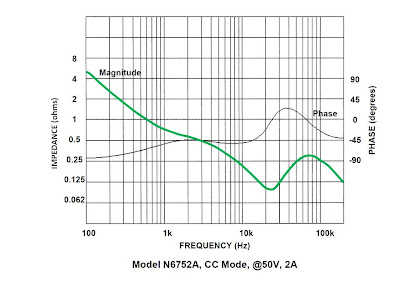This blog post and other great tips and tricks on Keysight's power products can be found on the Keysight Watt's Up? Blog.
For more information on Keysight Power Products visit: www.keysight.com/find/power
Friday, April 27, 2012
Can a standard DC power supply be used as a current source?
The quick answer to this question is, yes, most standard DC power supplies can be used as current sources. However, this question deserves more attention, so what follows is the longer answer.
Most DC power supplies can operate in constant voltage (CV) or constant current (CC) mode. CV mode means the power supply is regulating the output voltage and the output current is determined by the load connected across the output terminals. CC mode means the power supply is regulating the output current and the output voltage is determined by the load connected across the output terminals. When operating in CC mode, the power supply is acting like a current source. So any power supply that can operate in CC mode can be used as a current source (click here for more info about CV/CC operation).
Is a standard power supply a good current source?
An ideal current source would have infinite output impedance (an ideal voltage source would have zero output impedance). No power supply has infinite output impedance (or zero output impedance) regardless of the mode in which it is operating. In fact, most power supply designs are optimized for CV mode since most power supply applications require a constant voltage. The optimization includes putting an output capacitor across the output terminals of the power supply to help lower output voltage noise and also to lower the output impedance with frequency. So the effectiveness of a standard power supply as a current source will depend on your needs with frequency.
At DC, a power supply in CC mode does make a good current source. Typical CC load regulation specifications support this notion (click here for more info about load regulation). For example, an Keysight N6752A power supply (maximum ratings of 50 V, 10 A, 100 W) has a CC load regulation specification of 2 mA. This means that the output current will change by less than 2 mA for any load voltage change. So when operating in CC mode, a 50 V output load change will produce a current change of less than 2 mA. If we take the delta V over worst case delta I, we have 50 V / 2 mA = 25 kΩ. This means that the DC output impedance will always be 25 kΩ or more for this power supply. In fact, the current will likely change much less than 2 mA with a 50 V load change making the DC output impedance in CC mode much greater than 25 kΩ.
Of course, a power supply’s effectiveness as a current source should be judged by the output impedance beyond the DC impedance. See the figure below for a graph of the N6752A CC output impedance with frequency:
If the graph continued in the low frequency direction, the output impedance would continue to rise as a “good” current source should. At higher frequencies, the CC loop gain inside the product begins to fall. As the loop gain moves through unity and beyond, the output capacitor in the supply dominates the behavior of the output impedance, so at high frequencies, the output impedance is lower. So how good the power supply is as a current source depends on your needs with frequency. The higher the output impedance, the better the current source. The output impedance also correlates to the CC transient response (and to a much lesser extent, the output programming response time).
The bottom line here is that in most applications, a standard DC power supply can be used in CC mode as a current source.

